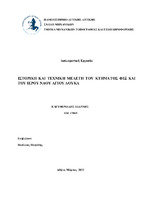| dc.contributor.advisor | Παγούνης, Βασίλειος | |
| dc.contributor.author | Ελευθεριάδης, Ιωάννης | |
| dc.date.accessioned | 2023-03-22T10:41:51Z | |
| dc.date.available | 2023-03-22T10:41:51Z | |
| dc.date.issued | 2023-03-10 | |
| dc.identifier.uri | https://polynoe.lib.uniwa.gr/xmlui/handle/11400/4011 | |
| dc.identifier.uri | http://dx.doi.org/10.26265/polynoe-3851 | |
| dc.description.abstract | Η παρούσα διπλωματική εργασία πραγματεύεται την «Ιστορική και Τεχνική Μελέτη του Κτήματος Φιξ και του Ιερού Ναού Αγίου Λουκά» στο Δήμο Ηρακλείου Αττικής. Θα γίνει μια ιστορική και τεχνική αναδρομή από την περίοδο ίδρυσης του Ελληνικού κράτους μέχρι σήμερα, που θα αφορά την πληθυσμιακή, την κτηματολογική και την πολεοδομική εξέλιξη της περιοχής μελέτης.
Η ιστορία της περιοχής του Ηρακλείου, στα Βόρεια προάστια της Αθήνας, χάνεται στην αρχαιότητα. Συγκεκριμένα, εκεί που υπάρχει το σημερινό Ηράκλειο, υπήρχε ο Δήμος Ηφαιστιάδων και υπάρχει αναφορά από τον Διογένη τον Λαέρτιο ότι ο
Πλάτωνας είχε στη κατοχή του ένα μεγάλο κτήμα. Τον τόπο αυτό διάλεξε το 1837 ο βασιλέας Όθων για εγκατάσταση των απόστρατων Βαυαρών που τον είχαν ακολουθήσει στην Ελλάδα και επιθυμούσαν την παραμονή τους. Αυτοί ήταν και οι
πρώτοι κάτοικοι της περιοχής που σταδιακά, λόγω του κλίματος (ξηρό και υγιεινό) και του φυσικού κάλλους, άρχισε να προσελκύει και άλλους κατοίκους.
Στα τέλη της δεκαετίας του 1910, εμφανίστηκαν οι πρώτοι κάτοικοι γύρω από το σταθμό. Τότε έγινε και ο γεωγραφικός διαχωρισμός: οι οικισμός γύρω από το σταθμό ονομάστηκε Νέο Ηράκλειο και ο παλαιός οικισμός των Βαυαρών Παλαιό Ηράκλειο.
Η Καθολική Εκκλησία του Αγίου Λουκά, αλλά και το Κτήμα της οικογένειας Φιξ, μέλος της οποίας ήταν μεταξύ αυτών που ακολούθησαν τον Όθωνα στην Ελλάδα, αποτελούν εμβληματικά σημεία της περιοχής, για διαφορετικούς λόγους. Στην
παρούσα εργασία θα αναλυθεί η εξέλιξη και των δύο, από τη δημιουργία τους, την πορεία τους μέσα στο χρόνο, και την εικόνα τους τη σημερινή εποχή.
Η τεχνική μελέτη πραγματοποιήθηκε με όργανα υψηλής τεχνολογίας και ακρίβειας. Ο γεωδαιτικός δέκτης που χρησιμοποιήθηκε για την εξάρτηση ήταν ο trimble 4700 δύο συχνοτήτων L1, L2 και τo μοντέλο του γεωδαιτικού σταθμού για τις μετρήσεις στο πεδίο είναι το southN6 series. Η εξάρτηση του τοπογραφικού διαγράμματος έγινε στο Ελληνικό Γεωδαιτικό Σύστημα Αναφοράς ΕΓΣΑ ’87. Εν συνεχεία, έγινε επίλυση των μετρήσεων και η απόδοση του Τοπογραφικού Διαγράμματος. | el |
| dc.format.extent | 140 | el |
| dc.language.iso | el | el |
| dc.publisher | Πανεπιστήμιο Δυτικής Αττικής | el |
| dc.rights | Αναφορά Δημιουργού - Μη Εμπορική Χρήση - Παρόμοια Διανομή 4.0 Διεθνές | * |
| dc.rights | Attribution-NonCommercial-NoDerivatives 4.0 Διεθνές | * |
| dc.rights | Attribution-NonCommercial-NoDerivatives 4.0 Διεθνές | * |
| dc.rights.uri | http://creativecommons.org/licenses/by-nc-nd/4.0/ | * |
| dc.subject | Κτήμα Φιξ | el |
| dc.subject | Άγιος Λουκάς | el |
| dc.subject | Όδευση | el |
| dc.subject | Αποτύπωση | el |
| dc.subject | GPS | el |
| dc.subject | Τοπογραφικό διάγραμμα | el |
| dc.title | Ιστορική και τεχνική μελέτη του Κτήματος Φιξ και του Ιερού Ναού Αγίου Λουκά | el |
| dc.title.alternative | Historical and technical study of the Fix Estate and the Holy Temple of Saint Lukas | el |
| dc.type | Διπλωματική εργασία | el |
| dc.contributor.committee | Ανδριτσάνος, Βασίλειος | |
| dc.contributor.committee | Γιαννίου, Μιχαήλ | |
| dc.contributor.faculty | Σχολή Μηχανικών | el |
| dc.contributor.department | Τμήμα Μηχανικών Τοπογραφίας και Γεωπληροφορικής | el |
| dc.description.abstracttranslated | This thesis deals with the "Historical and Technical Study of the Fix Estate and the Holy Church of Saint Loukas" in the Municipality of Heraklion, Attica. There will be a historical and technical review from the period of the foundation of the Greek state
until today, which will concern the population, cadastral and urban development of the study area.
The history of the area of Heraklion, in the Northern suburbs of Athens, is lost in antiquity. Specifically, where today's Heraklion is, there was the Municipality of Hephaistiades and there is a reference from Diogenes the Laertius that Plato owned a
large estate. this place was chosen in 1837 by King Othon for the settlement of retired Bavarians who had followed him to Greece and wished to stay. These were also the first inhabitants of the area which gradually, due to the climate (dry and healthy) and
the natural beauty, began to attract other inhabitants. In the late 1910s, the first residents appeared around the station. Then the
geographical separation took place: the settlement around the station was called Neo Heraklion and the old Bavarian settlement Paleo Heraklion. The Catholic Church of Saint Luke, but also the Estate of the Fix family, a member of which was among those who followed Otto in Greece, are emblematic points of the area, for different reasons. In this work, the evolution of both will be analyzed, from their creation, their progress over time, and their image in the present era.
The technical study was carried out with high-tech and precision instruments. The geodetic receiver used for the dependence was the trimble 4700 of two frequencies L1, L2 and the model of the geodetic station for the measurements in the field is the
southN6 series. The dependence of the topographic diagram was made on the Hellenic Geodetic Reference System EGSA ’87. Afterwards, the measurements were solved and the Topographic Diagram rendered. | el |


